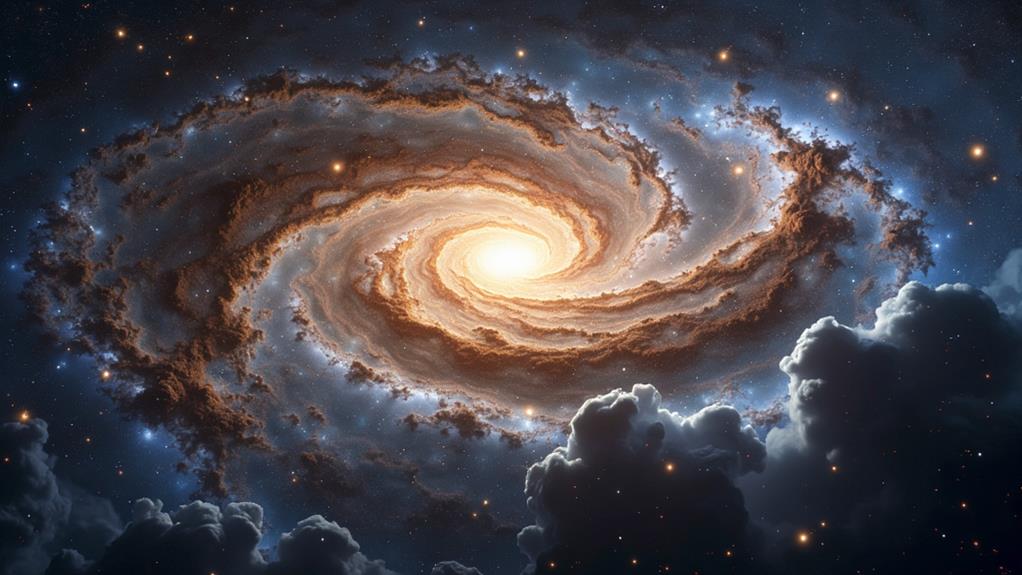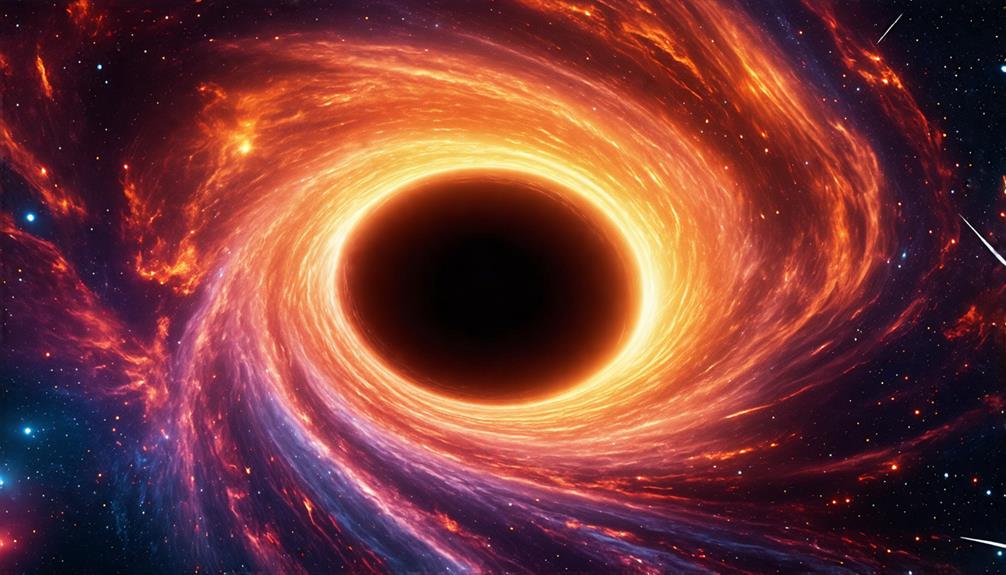How Supernova Explosions Affect Neighboring Galaxies
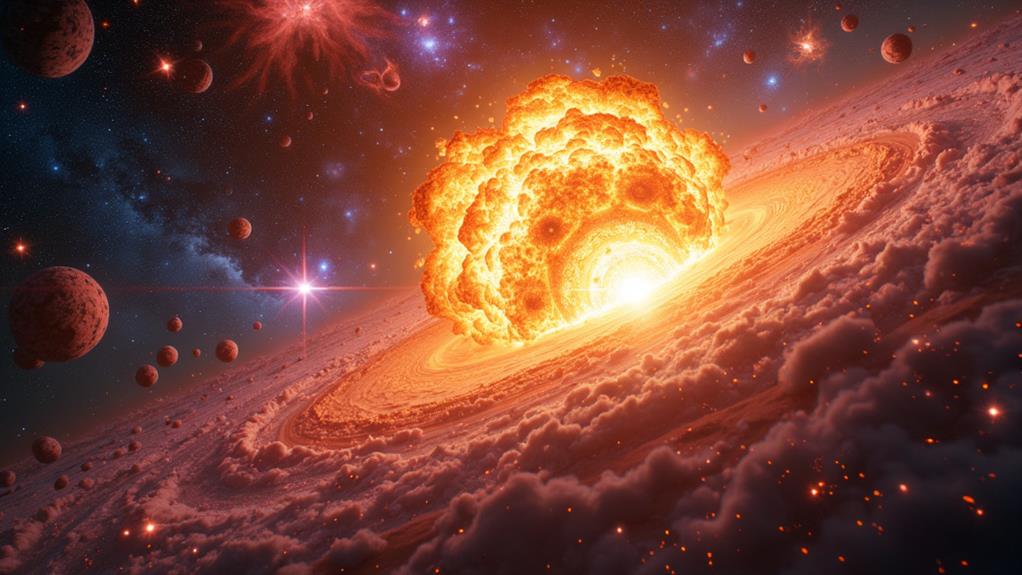
You'll see that supernova explosions dramatically influence neighboring galaxies by triggering new star formation and altering their chemical composition. When a supernova occurs, it sends powerful shockwaves through space, compressing nearby gas and dust. This compression can increase star formation rates by up to ten times. The explosion also releases heavy elements like carbon and oxygen, enriching the interstellar medium. Moreover, intense radiation ionizes surrounding material, which further alters the galaxy's chemical makeup. If you're curious about how these cosmic events shape entire galaxies, you're in for some fascinating insights ahead.
Key Takeaways
- Supernova shockwaves can trigger new star formation by compressing gas and dust in neighboring galaxies.
- High-energy radiation from supernovae ionizes surrounding gas, altering its chemical composition.
- Expanding gas shells from supernovae disperse heavy elements like iron and nickel into the interstellar medium.
- Supernovae disrupt nearby star systems, potentially ejecting stars from their orbits and creating gravitational instabilities.
- Observations confirm that supernovae create massive bubbles of hot gas, influencing the structure and evolution of neighboring galaxies.
Stellar Formation Trigger
Supernova explosions don't just denote the end of a star's life; they also act as catalysts for the birth of new stars. When a supernova explosion occurs, the shockwaves can compress the gas and dust in neighboring galaxies. This compression of the interstellar medium triggers the collapse of molecular clouds, leading to new star formation. Fundamentally, the explosion sets off a chain reaction that can result in the creation of new stars.
The shockwaves from supernovae create massive cavities in the interstellar medium, redistributing materials that fuel star formation in nearby regions. Studies show that the rate of star formation within a few hundred light-years of a supernova can increase by 3 to 10 times. This means that a single supernova explosion can improve the star formation activity considerably.
Moreover, supernova remnants enrich the surrounding medium with heavy elements like carbon and oxygen, which are vital for developing new stars and planetary systems. In dense stellar environments, the impact of a nearby supernova is even more pronounced, potentially leading to the formation of clusters of new stars within a few million years after the explosion. So, supernovae are not just destructive; they're also fundamental for creating new celestial bodies.
Radiation and Chemical Effects
While supernovae play a vital role in star formation, their impact extends beyond just creating new celestial bodies. When a supernova explodes, it emits high-energy radiation, including X-rays and gamma rays. This intense radiation can ionize surrounding gas and dust in neighboring galaxies, potentially altering their chemical composition. One of the notable chemical effects is the formation of nitrogen dioxide, which can impact the atmospheric chemistry of nearby regions and potentially cause cooling by decreasing sunlight penetration.
Additionally, supernovae contribute heavy elements to the interstellar medium, enriching the chemical makeup of neighboring galaxies. This enrichment is fundamental for the formation of new stars and planets, as these heavy elements serve as building blocks for new celestial bodies. The temperatures produced by supernovae, which can reach up to 15,000 K initially, lead to significant thermal effects. These high temperatures can influence the structure and formation processes of materials in nearby galaxies.
Shockwave Dynamics
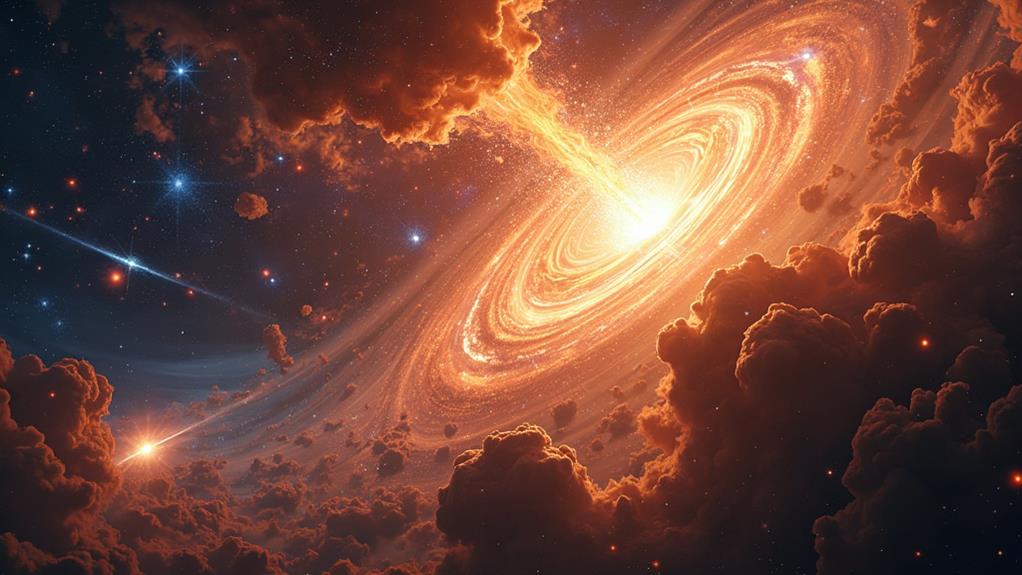
The colossal shockwave from a supernova can dramatically reshape its surrounding environment. When a supernova blast occurs, the shockwave can travel at speeds up to 10,000 kilometers per second, tearing through the interstellar medium. This powerful wave of energy doesn't just pass through; it creates massive bubbles of hot gas and dust. These turbulent regions can compress nearby molecular clouds, often triggering star formation in neighboring galaxies.
As the shockwave moves outward, its influence extends across several light-years, altering the structure and dynamics of the host galaxy's gas and dust. Observations of supernova remnants show just how far-reaching these effects can be. The energy released heats the surrounding gas to temperatures exceeding 10 million Kelvin, impacting the thermal balance and dynamics of these regions for millions of years.
Additionally, the interaction of the shockwave with the interstellar medium generates cosmic rays—high-energy particles that permeate the galaxy. These cosmic rays not only contribute to the galactic cosmic ray background but also play a role in the chemical evolution of galaxies. It's fascinating to see how a single supernova blast can instigate such profound changes, driving the processes that shape the cosmos.
Heavy Element Dispersion
As shockwaves from supernova explosions ripple through galaxies, they don't just reshape the interstellar medium; they also play an important role in dispersing heavy elements. When a supernova occurs, it releases a tremendous amount of energy, propelling heavy elements like iron and nickel at speeds of up to 10,000 kilometers per second. This rapid movement allows these elements to travel vast distances, enriching neighboring galaxies and contributing to their chemical evolution.
Type II supernovae, resulting from the collapse of massive stars, are particularly effective at synthesizing and distributing heavy elements. These explosions create expanding shells of gas and dust, which carry these vital elements into the surrounding interstellar medium. This process influences the formation of new stars and planets, ensuring that subsequent stellar generations have the required building blocks.
You can understand the impact of heavy element dispersion through the following points:
- Element Travel: Ejected materials can traverse vast galactic distances.
- Chemical Enrichment: Supernovae greatly enrich the interstellar medium with heavy elements.
- Star Formation: The presence of these elements affects the formation of new stellar generations.
Observations using spectral analysis have traced heavy elements in neighboring galaxies, revealing the far-reaching influence of supernova explosions on galactic chemical composition.
Impact on Star Systems
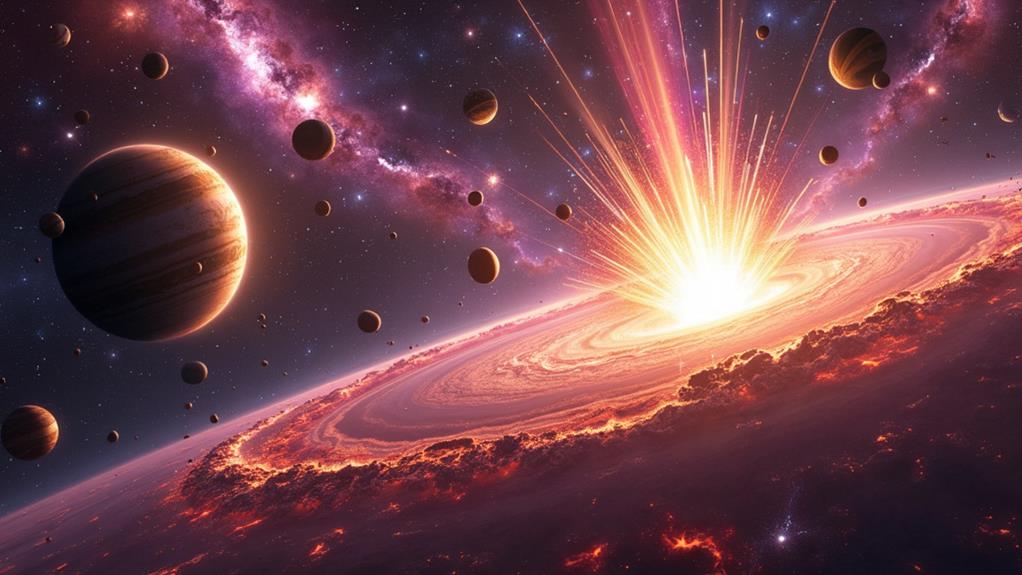
Supernova explosions pack a punch, releasing colossal amounts of energy and matter that reverberate through star systems. When a supernova exploded, it sends out shock waves that can trigger new star formation by compressing gas and dust in star-forming regions. These expanding gas shells from the explosion can also disrupt existing star systems, altering their gravitational dynamics. This disruption can lead to the ejection of nearby stars from their orbits, shaking up the stability of entire systems.
As the supernova's expanding gas shells travel outward, they contribute heavy elements to the interstellar medium. This enriches the chemical composition of neighboring galaxies, providing crucial materials for the formation of new stars and planetary systems. Moreover, the ionizing radiation emitted by the supernova can dramatically affect the surrounding environment. This radiation can alter the physical conditions necessary for star formation and impact the stability of protoplanetary disks, making it harder for new planets to form.
The aftermath of a supernova does more than just scatter elements; it influences the very gravitational fabric of star systems. The energy and matter released can create massive bubbles of hot gas, expanding and shaping the evolution of nearby star-forming regions.
Observational Evidence
Through careful observations and advanced technologies, astronomers have amassed a wealth of evidence showcasing how supernova explosions impact galaxies. Using powerful telescopes, they've uncovered that supernovae create massive bubbles of hot gas, markedly altering the interstellar medium of neighboring galaxies. This phenomenon affects the distribution of gas and dust, vital components in star formation.
Here are three key observational insights:
- Light Curves and Spectra: By studying the light curves and spectra from supernovae in other galaxies, astronomers have gained valuable information about the energy output and chemical composition of these explosive events. This data helps us understand how supernovae enrich the interstellar medium with heavy elements.
- X-ray Emissions: Data from satellite missions have shown that supernova remnants emit X-rays, which can be detected and analyzed. These X-rays provide essential information on the impact of supernovae on the structure and dynamics of the interstellar medium, revealing how shock waves propagate through space.
- Star Formation Triggers: Observations indicate that supernovae can trigger the formation of new stars. The shock waves produced by these explosions compress the surrounding gas and dust, initiating the star formation process in neighboring galaxies.
Frequently Asked Questions
How Do Supernova Explosions Influence Our Galaxy?
Supernova explosions play an essential role in our galaxy. They drive stellar nucleosynthesis, enriching the interstellar medium with heavy elements. Shock waves from these explosions compress cosmic dust, sparking star formation and influencing galactic evolution. You'll notice that they also affect the dynamics of circumstellar disks, shaping solar systems. When a supernova occurs, it's a cosmic event that significantly impacts our galaxy's structure and future.
How Do Supernovae Affect the Formation of Life in Galaxies?
You might wonder how supernovae affect the formation of life in galaxies. They play an essential role by releasing heavy elements into the interstellar medium, leading to chemical enrichment. This enriches stellar nurseries, where new stars and planets form. Cosmic radiation from supernovae can also influence the chemistry of protoplanetary disks, shaping future planets. These processes collectively create conditions that can support life formation, despite their disruptive nature.
What Happens to Nearby Planets During a Supernova?
During a supernova, nearby planets experience intense radiation effects, leading to the ionization of planetary atmospheres and the formation of harmful compounds. Gravitational waves and shockwaves can disrupt climates and strip atmospheres, impacting potential habitability. Chemical enrichment from the explosion can alter surface compositions, while increased cosmic rays raise mutation rates and radiation damage risks. Generally, supernovae greatly threaten the stability and habitability of nearby planets.
Why Are Type I Supernova Explosions Useful to Find Distances to Distant Galaxies?
Type Ia supernova explosions are incredibly useful for finding distances to distant galaxies. You use them as standard candles because their consistent peak luminosity makes them a reliable cosmic yardstick. These stellar explosions allow precise distance measurements by comparing their known brightness to observed brightness. This method has transformed astronomy, helping you determine galaxy distances and understand the universe's accelerated expansion. They're a crucial tool in cosmic distance measurement.

